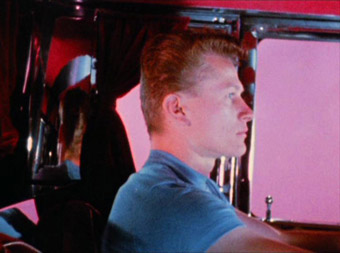| |
"Photography is a blatant attempt to steal the soul ... [Making films is] a transparent excuse for capturing people." |
| |
Kenneth Anger, Cinema magazine, 1969. |
Everyone likes mystery, and there are few figures more mysterious than Kenneth Anger. Before we can talk of the man, we must talk of the myth. Even the simplest of his biographic details, such as place of birth, age, and where his formative years were spent are subject to questioning. For anyone seeking solid information, researching Anger is something of a factual minefield. According to the accounts you read, details shift – he was either a precocious seventeen-year-old or a cocksure young man of twenty when he made the seminal homoerotic short Fireworks; he either lived in the Los Angeles suburb of Santa Monica or reflected in the glamorous glow of Beverly Hills, amongst the stars of old Hollywood he so admired – and that is just the beginning, before the occult, the ritualistic leanings of Rabbit's Moon, and, of course, the entrance of Aliester Crowley into Anger's life and consciousness.
And yet, it's the ambiguity, the never quite knowing who or what Kenneth Anger s, akin to fictional eccentrics like Willy Wonka and The Wizard of Oz. If you're in need of a more concrete, and possibly more appropriate example, perhaps Anger is filmmaking equivalent of Gary Cooper, if you are in need of a more concrete example. Like Cooper, it seems Anger wasn't born, he was madeactually that makes him so infinitely intriguing. Indeed, his fitting self re-appropriation as Kenneth Anger, which trips off the tongue as nicely as Sid Vicious, and much more easily than his original given name Kenneth Wilbur Anglemyer, sparks off a multitude of ideas concerning constructed persona.

If it sounds like I'm decrying Anger or casting him as a fake, I'm not. For all his controversy, Anger was indeed a talent; a prodigious if not a prolific one. The fragmentary nature of his work, perpetuated by accounts of films lost, destroyed or simply abandoned, only seems to further feed desire to paint Anger as a creative genius, thwarted by bad luck. While that could hold some element of truth, I feel it's no coincidence that the tattoo emblazoned across the chest of this messiah of art's underground, 'Lucifer,' is also the name given to a lost film work, rediscovered after a time. I'm sure such comparisons would amuse him.
But what of that work? What of that frenetic output, smattering cinematic history like comets or supernovas, leaving behind debris of viewers that are inspired, awed and confused in equal measure. These are films that defy classification and essentially defy description, much like their creator. Even with modern eyes, they look like they was sent from another planet – even the retrograde leanings of Scorpio Rising, and its evocations of Brando and Dean don't exclude such it from such an analogy – with Anger like an alien visitor from a far off land, exhibiting the wears of his superior intelligence. Describing him in that way makes his work seem like something of a novelty, but it feels more anomalous. The aesthetic of these films and their construction go against the grain of film as being an evolutionary process. When you place the chronology of Anger's work against the technological and artistic innovations of the time, they barely correlate. It further proves that Anger was most certainly ahead of his time, but more importantly, begs the question whether we can ever catch up with him.
All too often, words like 'visionary' and 'innovator' are bandied around with such freedom that they lose their potency and are rarely corrected attributed. Potency too, is something that Anger's work has in spades. In this case, the truth of that statement can be counted upon. It could be argued that given the passage of time, their ability to shock has become as dilute as the impact of their style, and the proliferation of fast-paced editing and pop music in film since their making have therefore rendered the Cycle an antiquity and a clichéd one at that. But, while it's easy to find filmmakers past and present who have fallen under Anger's spell – everyone from Martin Scorsese to Gus Van Sant has spoken of his influence upon their own output – it's less so find work that's comparable in order to fully understand if Anger's work can be assessed in that way. Whether or not a work feels dated is a subjective practice, and the answer will always differ, regardless of who is at the helm.

Finding myself nearing the end of the Cycle, I became, angered, for want of a better term. Like the greatest magicians and artists, it feels like Anger the filmmaker – whether by accident or design – was cut off in his prime, in favour for Anger the author. As a consequence, I was left wondering what else he could have achieved and the heights it could have reached. That, is a whole other story and an even bigger mystery to ponder.
The medium of DVD was made for someone like Kenneth Anger, for the simple fact that it's something of a democratic and increasingly valuable mode of exhibition. It today's climate it's hard to imagine exactly where Anger's films could be shown. In the halcyon days of Channel Four, this kind of work would have fitted right in with its remit, but now, it's hard to imagine such an occurrence, even in the scheduling black hole of the early hours. Theatrical re-release on a mainstream scale seems even less likely. Anger is too provocative, too niche and too odd for tastes beyond the arthouse Likewise, though these films are indeed art, it doesn't feel entirely right to see them as part of an installation in an art gallery (even though a retrospective of Anger's work is currently running at the P.S.1 in New York, until September 19), such a practice, though important for Anger and art – since it goes some way to break down the elitism between art on canvas and art on celluloid – is the equivalent of placing a pretty bird in a cage; it is far too limiting a stage.
This is where DVD comes into its own, and particularly in the case of Anger, since it provides the opportunity for the obscure and the 'difficult' to find a home and an audience of potentially limitless size. The primary function of sets like the Magick Lantern Cycle are of course that the work been seen at all, but, increasingly, DVDs (and Blu-ray) are created in order to allow films to be kept, preserved and restored to their best; turning them into an artefact as well as a source of entertainment. In the case of these films, the work valuable and painstaking undertaken by the BFI, UCLA's Film and Television Archive and The Film Foundation is exemplary of such an ethos, and shows an inspiring level of commitment to safeguarding important and influential work such as this. As a result, film culture in the present is enriched without forgetting its past.
[1947] (14:24)
Aptly, this film is the light to Kenneth Anger's creative touch paper, and turned him into an overnight sensation. The experience of watching this film is very much like a dream: fragmentary, confusing, alluring and surreal all at once, with an immensely haunting quality, heightened by its Respighi soundtrack. Stylistically, it owes much to the work of Salvador Dali, Luis Buñuel and Jean Cocteau; the latter served as a large source of Anger's inspiration. When considered in context this film is a remarkable one, created during the era of the Hays Code, when the lives of gay and lesbian men and women were most certainly led in closet. Not only is it an incredibly bold opening statement for Anger, it's also a landmark for film history, through it's open exploration of male sexuality and desire, predating Jean Genet's more explicit homoerotic short, Un chant d'amour/A Song of Love, by three whole years. While its imagery isn't particularly subtle, it remains a powerful and important film, with a reputation that's more than deserved.

Several versions of the Fireworks have been shown over the years, at first without any kind of title sequence at all. The original negative and Anger's subsequent hand-tinted prints were lost. The version presented here – restored by UCLA – is constructed from early 16mm prints and contains Anger's narrated prologue.
PUCE MOMENT [1949] (6:04)
A teasing, beautiful little fragment of what would have become Puce Women, which is made all the more intriguing since it is Anger's first use of colour stock, and sets up the vivid colour palette and pop music soundtracks (in this case, the songs of Jonathon Halper) which would come to define is work. Anger envisaged this as something of a symphony, with women representing different parts of the day. This 'moment' captures woman (Yvonne Marquis) as she chooses a dress to go out in. Also an ode to old Hollywood, and the women of the silent era he so admired. Anger specifically sought out women for their likeness to the actresses of the period and clothed in dresses from the time, lent to him by his wardrobe mistress grandmother, shot in a house set in the Hollywood Hills. His attention to detail extends right down to the film's shooting style, slowed to eight frames per second to replicate the jerky speed of hand cranked cameras.
Unfortunately, this short sequence is all he could afford to shoot.
[1950/1971 version] (16:12)
Made by Anger's own company, Puck Films, the setting shifts to Paris for this one, and was unreleased for over two decades, and remains unfinished. This is heavily steeped in Japanese mythology and uses the characters of Pierrot, Harlequin and Columbine found in Italian Commedia dell'Arte. The action is set to 1950 Do-wop music, including the The Capris and The Dells. Anger's band of moon-gazers are played by professional mime artists. Rabbit's Moon exhibits a very different kind of beauty to that of Puce Moment, and the film's blue-tinted stock is clearly influenced by another Anger favourite, Joseph Von Sternberg. It reminds a great deal of silent era Shakespearian adaptations, a fitting comparison given Anger's involvement in the William Dieterle and Max Reinhardt production of A Midsummer Night's Dream as a child, retaining that childlike sense of wonder and innocent romanticism. Though it has the same dream-like tones of Fireworks, it shows a very different side to Anger, and is a much calmer and softer affair than later films in the Cycle.

The version presented first on the disc is the rarer, longer cut, reconstructed shot-for-shot by UCLA, restoring it to the correct orientation – Anger's original was mirrored during the transfer process from 35 to 16mm stock. Their restoration work definitely shows here and it's beautifully presented; the blue hue replicating the moonlit night really pops. The shorter version, which gained wider circulation, appears later.
[1953] (12:35)
With its ethereal, abstract feel and blue-tinted stock, this feels very much a companion piece to Rabbit's Moon, perhaps, given its Tivoli setting, its Italian cousin. Its title is a clever little pun on feux d'artifice, the French word for fireworks, which is, of course, a nice little self-reflexive reference to his first film, for all you meta-reference fans out there.
Where light and/or fire has been the principle theme in previous works, Anger turns aquatic here, showing off imagery of jewel-like, dancing fountains, amidst more fairytale creatures, this time, in the form of a rather splendid, regal looking water witch. It's exemplary of the kind of poetic, or haiku film that Anger desired to make, which he discusses in his piece for Cahiers du Cinéma (see my description if the accompanying booklet for more details). Even though it seems an ill-fitting word, the 'prettiness' of this film is topped off by Anger's choice of music. Instead of working against the image or to further comment upon it – as in the later incarnation of Rabbit's Moon – this one compliments it entirely. The use of Vivaldi's winter movement of the Four Seasons in the latter portion of the film, acts as the cherry on top of a rather elegant cake.
However, Unlike Rabbit's Moon, the beauty of it and its scenery is somewhat lost due to the quality of the print, this is minor quibble given how good the other films parts of the Cycle look. Up until to this point, we've been somewhat spoiled, so when presented with a less than stellar example, it certainly stands out. But, it's important to remember we're watching a film over fifty years old, the fact that it's survived at all is cause for celebration, which tempers that disappointment slightly. Though it may be a lesser known film in the director's career, Eaux d'Artifice carries the distinction of being the only Anger film to be preserved in the Library of Congress.
[1954] (36:53)
This film is very different kind of Anger landmark, standing as his longest piece of work and took three months to complete. Even though it has been overshadowed somewhat by the reputations of Fireworks and Scorpio Rising, it's still an important film. He got the idea for the film after attending a Halloween party, hosted by the artist Renate Druks in the home of Sampson De Brier. Attendees were instructed to 'Come as your own madness.' Upon seeing his friends in costume – many of whom were dressed as the mythological characters he was fascinated and inspired by – he decided to make a film based around them. The result on screen is appropriately decorous and decadent.

Inauguration takes its name from a line of Samuel Taylor Coleridge's poem, 'Kubla Khan' ('in Xanadu did Kubla Khan/a stately pleasure-dome decree'). The pleasure in this film of course stems from the obvious joy Anger takes in using colour. A definite 'look' is beginning to build here, thanks to his predominantly red palette, which is augmented with flashes of neon hues and ritualistic imagery. Inauguration is full of hints of what's to come in Invocation of My Demon Brother. Vivid perhaps to the point of needing sunglasses, it's what one imagines would happen if a rather creatively-minded Technicolor-era Hollywood cinematographer would do if given free rein. It's rather like watching a child – albeit a very gifted one – let loose with their paint box. Everything from Harry Lachman's Dante's Inferno to his own earlier film, Puce Moment, gets put into the mix – with a little Aliester Crowley art sprinkled in for good measure. Anger's stylistic alchemy is concluded with the use of another grandiose score, this time opting for Janáček's Slavonic Mass.
If it wasn't obvious before, this is the film, which, for me at least, confirms Anger as a lover of cinema as well as a maker of it. Fittingly, this is something of an homage to cinema, and throws in some neat – if a little obscure – references in the form of Anger's cast members, with filmmaker Curtis Harrington playing (amongst others) Cesare the Somnambulist, from Robert Wiene's German expressionist milestone, Das Cabinet des Dr. Caligari/The Cabinet of Dr. Kaligari. The director also makes a cameo, barely recognisable as Hecate, Grecian goddess of Witchcraft and Magic. For those less well-versed in the various kinds of history and mythology it references, Anger's commentary on this is a great listen, and makes the film a much more enjoyable and less alienating experience.
[1964] (27:20)
Arguably, this is the most widely-known, influential and highly-regarded film of Anger's output, and is often cited as the film which introduced people to his work. To use the term 'mainstream' in regard to Anger seems rather ridiculous, but in comparison to more difficult parts of the Cycle, such as Invocation of My Demon Brother, Scorpio Rising is much more accessible film. If a complete Anger novice, it's also the best place to begin exploring his work and is often cited as most people's introduction to it.

Anger trades in the figures of mythology to follow real people, in this case, a group of bikers, whom Anger befriended upon his return to New York from his European travels. The men accepted him, and allowed him to film them; the final edit focusing on their leisure spent partying and maintaining their beloved bikes – much like the boys in the film that would follow it, Kustom Kar Kommandos. The figure of Bruce Byron (Scorpio), is a fascinating one, his good looks and daredevil attitude are an obvious nod to Marlon Brando and James Dean, both of whom appear in different forms throughout the film: Dean is shown in the form of a poster on Scorpio's wall, whilst Brando's The Wild One forms part of the diverse set of found footage which is intercut with, and sometimes superimposed over, the actions of the gang in the manner of Inauguration of the Pleasure Dome.
In addition to its visual style, the most striking and indeed surprising aspect of this film is its use of music. Typically Anger in its variety and pioneering approach to usage, the soundtrack consists of thirteen songs, including Elvis Presley, Ray Charles, The Angels and The Crystals. Most interestingly of all, his use of Bobby Vinton's 'Blue Velvet,' beats David Lynch the punch by over two decades. Rather than playing simply as a decorative adjunct to add flavour, the songs are often used to comment upon the events on screen, adding to and in some cases altering the meaning of the sequence. Anger's approach wasn't adopted by mainstream cinema until much later in the sixties, most obviously through the films of Martin Scorsese. Now, of course – like so many of the director's techniques – the practice is commonplace, with the lack of a soundtrack that rolls like a well-stocked jukebox becoming the rule, rather than the exception as it was here.
I'm not entirely sure if I agree with the idea that the film contains homoerotic imagery. Yes, the subtext is there, but that may be endemic of the propensity we have for trying to find extra meaning where there is none. I doubt that Anger specifically set out to create something with such a specific agenda. In fact, it's more likely that Anger's liberal views in regards to sex and sexual desire mean that his films offer up a reversed version of Laura Mulvey's famed 'male gaze' theory, but 'female' seems the wrong categorisation for it. As ever, even down to the smallest detail, Anger is in a class of his own.
Thanks to the behaviour of the gang at a Halloween party, including brief nudity and drugtaking, the film was subject to an obscenity lawsuit, but by today's standards it's tame; comparable to similar scenes later on in the Cycle. Of all of Anger's film's Scorpio Rising is the one that holds the most resonance for a modern audience, especially given the iconic status of Brando, Dean and men like them. Like all the best icons, Scorpio's tale has a tragic end. Though he wasn't the biker killed in the crash at the close of the film – Anger chose to maintain the man's anonymity – an accident a few years later would cost Bryon his life.
[1965] (3:16)

Like Rabbit's Moon before it, this is another Puck Films production, conceived as part of a bigger project, in the vein of Puce Moment. The film plays like a rather creative car ad: part grand love story between one man and his car, part love letter to a bygone era. In contrast to Fireworks, which placed real-life friends of Anger who had served in the Navy in a fictitious narrative, this film, like Scorpio Rising, has a rather documentarist impulse – it's subject, Sandy Trent, was just another person who willingly allowed Anger to film him as he built, tested and maintained his 'dream buggy,' a customised Model T Ford – it still carries that strange kind compelling beauty which threads throughout Anger's films.
The handsome Trent wouldn't look out of place in a teenpic, the embodiment of the 'Dream Lover,' The Paris Sisters longed for, their song playing over the top of his actions like a lovesick lament. His immaculate dress set against the pink background and his polished silver car just add to his allure. Indeed, one can't help reading into what we're seeing and find homoerotic subtext as with Scorpio Rising.
Sadly, Trent was killed in a drag race accident and Anger failed to secure any further funds for the project. This short fragment is all that remains of it.
[1969] (10:30)
This was Anger's failed attempt to make Lucifer Rising, which he dubbed his 'war film,' and uses footage of the Vietnam War and other news reel from the time, intercut with the invocation ceremony of the title. After an argument with friend, collaborator and protégée Bobby Beausoleil saw the film's negatives stolen, leaving him with only the scraps from the editing bin, Anger put these fragments together and made Invocation. Necessity as they say breeds invention. Upon learning this anecdote, I couldn't help but think how indicative it was of Anger's pioneering spirit and fierce independence, determined to make the best of the situation. A determination which was no doubt driven by the desire to show Beausoleil he could get along without him, and salvage something of the project at the same time.

The nature of its construction makes Invocation a rather haphazard and confused piece, which only seems to aid its occult and ritualistic influences. Its improvised Moog synthesizer soundtrack created by Mick Jagger (who also appears in Rolling Stones concert footage seen in the film), only heightens the film's elemental and otherworldly feel, sounding like some strange off-world radio station in the process of tuning. Elsewhere, Anger plays with the imagery and symbolism connected to light and darkness –a common element in his work – is particularly powerful. However, To make it to the end is something of an exercise in discipline, but it's an early example of his experiments with superimposition, and the kind of associative cutting he would later implement in Scorpio Rising, which makes it a compelling one to watch from the point of view of editing and composition.
[1950/1979 version] (6:29)
Just as charming and humorous as its longer counterpart, this version was created by reproducing every second frame, speeding up the character's movement, as a birthday gift from Anger to Roark Brakhage, the son of fellow experimentalist filmmaker, Stan Brakhage. Beside the length, the only major change comes in the look of the moon itself – opting for a real moon against a cloud streaked night sky – and Anger's choice of soundtrack, which swaps out the Do-wop out the other tracks for 'It Came in the Night,' by 1970s band, A Raincoat, perhaps a nod toward the tastes of its intended viewer, and contemporaneous music at the time of its release.
Thankfully, the care taken in the restoration of the longer cut has been replicated here and it looks just as good.
[1981] (27:05)
Completed in 1972, but released nine years later, another Puck Films production, Lucifer Rising brings the Magick Lantern Cycle to an end. Barring further sporadic shorts including documentary pieces on Aliester Crowley, The Man We Want to Hang, and this year's My Surfing Lucifer, about life of Bunker Spreckels, professional surfer and son of screen legend Clark Gable, this is his last significant work, drawing to a close the arc of creativity that began some three decades earlier with Fireworks.
While it may be the end for Anger, it also feels like he's come full circle, since it resurrects, and finally realises his earlier plans for Lucifer, which he set in motion some years earlier, thwarted by the breakdown of his relationship with Bobby Beausoleil. The project's links with Beausoleil – now imprisoned for murder – would be rejuvenated after he stepped in to provide a suitably psychedelic score, when the director's plans with Led Zeppelin guitarist Jimmy Page fell apart. Further connections to Invocation come in the form of Haydn Couts as The Magus, who bares a striking resemblance to both the young Anger and the incarcerated Beausoleil, that one can't believe that the director's discovery of him was accidental. Over the years, Anger's casts have included a few famous names and Lucifer is no exception. The role of Lilith, a Mesopotamian demoness is played by singer-songwriter and actress, Marianne Faithfull. Her appearance is proof of just how well-connected and influential he had become.
The film itself is – thankfully – quite different from its earlier incarnation. Though it retains the ritualistic and magical elements of Invocation, it dispenses with its headache-inducing soundtrack, and opts for an earthier colour palette, no doubt inspired by its global locations. This, combined with nature footage, gives the film a rather more Earthly, rooted feel. There's a real sense of exotic grandeur about this film, which makes you wonder if Anger was beginning to enter a different phase in terms of his signature aesthetic: Anger's work has always been confident, but this film especially carries an aura of maturity I hadn't previously felt. However, like its predecessor, it retains a visual denseness which makes it quite a challenge to watch – a very rewarding one, but a challenge nonetheless – which probably contributed to the less than enthusiastic critical response it received. Ultimately, I doubt that matters much to Anger, since, as a filmic swansong, few sing as sweetly or as loudly Lucifer Rising does.
Inevitably there is going to be some variance in the image quality given the difference in age, film stocks and restoration materials. You only need to check out the extracts included in the Anger Me documentary to see how good the restoration work is.
The detail on Fireworks is a little soft and the grain very evident, but black levels are rock solid and the contrast about right for the film stock. There is some light flickering at frame sides and the odd scratch, but this is likely as good as the film has ever looked on home video. The most immediately striking thing about Puce Moment is the colour, which is vividly reproduced – detail is still a touch soft at this stage (more in some shots than others) and the film grain very much part of the aesthetic, but the picture has been very nicely cleaned up, with only the odd small scratch still visible. Rabbit's Moon looks terrific, with noticeably crisper detail than its predecessors that looks very good on DVD and even better on the Blu-ray. The film's blue tones are beatufully reproduced without compromising the contrast at all. Grain is back for Eaux d'Artifice, which as detailed above also suffers from more print flaws than the other films in this set, though at its best the image quality is still impressive. As with Rabbit's Moon, the blue tones are well captured and the blacks are strong. Richness of colour is the most striking element of the transfer of Inauguration of the Pleasure Dome, which again boasts well balanced contrast and a clean print, though there is very slight judder to some shots and sharpness is not quite up to that on Rabbit's Moon. But oh, the colour... The contrast on Scorpio Rising is not quite as consistent as the previous films and film grain is once again part of the look, but the print is cleaner than any I've previously seen and the sharpness likely as good as the original materials will allow. The grain is a little finer on Kustom Kar Kommandos, the detail a little clearer and the contrast more consistent. Colours are also brighter here. Invocation of My Demon Brother is less consistent in its contrast, but this could well have been and artistic choice or down to lighting conditions for individual shots. The sharpness and contrast on some shots is still very impressive and the reds in particularly vividly reproduced. Although the most recent film in the set, Lucifer Rising's more muted colour scheme and softer detail has the look of an earlier work. There's the odd bit of picture judder and even a hair in the gate on one shot, but these are very likely original film elements rather than a transfer issue.
On the whole, this is a very impressive set of transfers from material that was never going to provide material for a show-off Blu-ray disc. As a result, the differences between the DVD and Blu-ray aren't that huge, and nice though the BD disc is, if you're looking to save a few pence you won't feel you've lost out if you plump for the DVD. All the films are in their original 1.33:1 aspect ratio.

The soundtracks are all either 2-channel mono or stereo, depending in the film's age, Dolby Digital on the DVD and PCM on the Blu-ray. Dynamic range is a little limited on the earlier films but are noticeably clearer and with more stable treble and deeper bass on the more recent works. Both versions of Rabbit's Moon sound good, but the instrumental scores of the earlier Eaux d'Artifice and Inauguration of the Pleasure Dome are clearer than you might expect. There's a rather crisp treble bias to Dream Lover in Kustom Kar Kommandos, while the bass flicks of Jagger's Moog improvisations in Invocation of My Demon Brother should guarantee a headache in the unsympathetic. Sonically the best of the bunch is Lucifer Rising, a very clear and spacial stereo track that serves the music well.
Disc 1:
This first disc has 'play all' feature, allowing you to watch all of the films in the Cycle one after the other. Though it's a useful tool, and gives a sense of cohesion – intended or not – to a body of work completed across a thirty-four year span, I wouldn't recommend using this facility if watching Anger's work for the first time. Many of the films work much better in isolation and definitely benefit from repeated viewings.
Commentaries by Kenneth Anger which are newly recorded for the set, are provided for all the films in the Cycle and are optional. Although the depth of discussion Anger can reach is somewhat restricted by the length of the films themselves – sometimes he's abruptly cut off mid sentence when the film itself ends – and have the odd dead spot, but they are most certainly worth a listen, coming into their own on longer works such as Lucifer Rising. Each offer an invaluable perspective on Anger's filmmaking techniques - with the odd amusing anecdote and namedrop thrown in – as well as providing further contextual information, which shed light on different obscurities related to the films at hand, such as the mythological references in Rabbit's Moon and Inauguration of the Pleasure Dome, and background details for the less well-known constituents of the Cycle.
The Man We Want to Hang [2002] (13:11)
This is Anger's documentary on Aliester Crowley, filmed at the October Gallery in London. It presents a number of his artworks and personal artefacts, set to the music of Russian composer, Anatol Liadov, acting as a sufficiently dramatic and sometimes demonic accompaniment. Anger's camera zooms in on and/or pans to show details of larger pieces whilst others are left to stand on their own, creating the feeling of walking around the exhibit, pausing every so often to look at things that catch our – or rather Anger's – eye.
While some of the elements from the earlier Fantoma release[s] have been retained, others have been discarded. In this case, it means we lose an additional commentary by Anger, which provides some much-needed contextualisation for what we're seeing, and it's a real shame it wasn't included. In its absence, the relevant segment within Gelmini's Anger Me is an adequate replacement.
Restoration Demonstration (5:50)
This is an interesting little feature, which uses a number of techniques to show various original and restored prints of films from the Cycle side-by-side; a common element of lengthier restoration featurettes on other DVD releases. Unfortunately, it's let down by the fact that it's unaccompanied by any form of commentary or interview-based discussion of the various stages of clean-up. Without that guidance, it's quite hard to fully appreciate the degree of difficulty and amount of work such restorative processes entail.
Disc 2:
Anger Me [2006] (71:20)
Elio Gelmini's feature-length portrait of Anger takes up the entirety of the second disc, with the option to watch it from start to finish or select scenes from a chapterised list, the majority of which are named after the Magick Lantern Cycle. After a kinescope opening sequence showing Anger's films, we open with fellow experimental filmmaker and Anthology Film archivist, Jonas Mekas, affectionately describing his meetings with and opinions of the director. Afterwards, the perspective shifts toward Anger himself, combining his discussion with photographs and archive footage. A lot of what is said here has also found its way onto the various commentary tracks, and feels like a better medium for the purpose, since Anger is allowed to go into more depth. Despite this, it's still a fascinating viewing experience for those eager to learn more about Anger or those who simply enjoy hearing him talk about his life and career. As such, Gelmini's film is a nice companion to the entire set and certainly gives it a more rounded feel.
Booklet
This rather handsome full-colour booklet is illustrated with stills, supplied by BFI and Anger himself, some of which are rarities in their own right. Alongside this are production credits and restoration notes for each feature. The majority of the booklet is given over to essays – different from those contained the booklets for the Fantoma releases – separated by Anger's sketches for the abandoned project, Puce Woman. The first of these is a reproduction of Anger's 1951 piece for Cahiers du Cinéma, 'Modesty in the Art of Film.' This is a treat in many respects, both from the perspective of film criticism, and to see or rather read, evidence of Anger's mind at work. Aside from a great rhetoric, it shows just how passionate and knowledgeable Anger is regarding cinema; something of a revelation when considered against the less than glowing associations he would gain for writing Hollywood Babylon. The second essay is a lengthier, detailed piece by Gary Lachman, 'Kenneth Anger: The Crowned and Conquering Child,' which explores Anger's biography and career, in an episodic and thematic manner, with plenty of historical and social context for the genuine Anger novice; quite different from the sometimes quite bland biographical article. Given its subject, that's a fitting assessment.
Also included is a fold-out BFI DVD and Blu-ray release catalogue, Highlights include Pier Paolo Pasolini's The Decameron, Chris Newby's Anchoress, and Richard Lester's The Bed Sitting Room, from the first wave of its new 'Flipside' strand.
Collected together as one box set for the first time, restored to look and sound as best as they possibly can, technology at least seems to have finally reached Kenneth Anger's speed. The Magick Lantern Cycle is an avant-garde cinematic landmark, and a grand at that. For anyone with an interest in experimental and/or underground cinema, this is an essential purchase. For those seeking an answer as to whether Anger is worthy of his status as a cultural icon, they need only hit the play button.
|